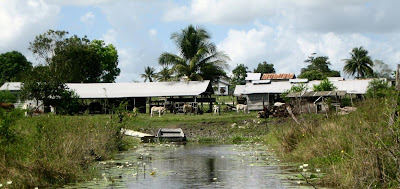 Along the way, we saw all these curious flags in many houses. It turns out they had had a sharply contested election in February and the Prime Minister had been removed from office in the process. Each party has its own flag.
Along the way, we saw all these curious flags in many houses. It turns out they had had a sharply contested election in February and the Prime Minister had been removed from office in the process. Each party has its own flag. This poster warns Musa, the current Prime Minister for the last 10 years, that the town of Tower Hill is ready to challenge him at the elections. Notice the written pidgin English. Tower Hill has one of the sugar mills that we passed along the way to the New River. The mill processes raw cane from January to June.
This poster warns Musa, the current Prime Minister for the last 10 years, that the town of Tower Hill is ready to challenge him at the elections. Notice the written pidgin English. Tower Hill has one of the sugar mills that we passed along the way to the New River. The mill processes raw cane from January to June. These are Mennonite young people enjoying the river.
These are Mennonite young people enjoying the river.About 3,000 Mennonites relocated to Belize in 1959 along the Rio Hondo (and now the New River) in search of freedom of religion and freedom to do their own thing. They signed a special agreement with the Belize Government which exempt them from military service and certain forms of taxation and guarantees them complete freedom to practice their own distinctive form of Protestantism and farm within their closed communities. They also have their own form of local government and run their own schools, banks, and businesses. Our Belizean guides told us that they have agreed NOT to export any of their production in exchange for their special exemptions.
 This is an exceptionally nice house in partial state of construction. Because of hurricanes, most houses in Belize and Eastern Mexico are built using reinforced concrete. The country looks poor. Most houses are in various states of crumbling or reconstruction.
This is an exceptionally nice house in partial state of construction. Because of hurricanes, most houses in Belize and Eastern Mexico are built using reinforced concrete. The country looks poor. Most houses are in various states of crumbling or reconstruction. Kids play with a soccer ball people walk among buildings.
Kids play with a soccer ball people walk among buildings. This is a pretty nice school. A Spanish language sign in front says that it is a gift from the people of Mexico to the People of Belize. Notice the Belizean blue flag with red top and bottom borders and the Mexican flag in the mural.
This is a pretty nice school. A Spanish language sign in front says that it is a gift from the people of Mexico to the People of Belize. Notice the Belizean blue flag with red top and bottom borders and the Mexican flag in the mural. School kids wear uniforms and walk to bus stops.
School kids wear uniforms and walk to bus stops. Sugar cane appears to be one of the main agricultural crops. Here is a semi heavily loaded with sugar cane.
Sugar cane appears to be one of the main agricultural crops. Here is a semi heavily loaded with sugar cane. Fruit picking - mainly oranges and bananas are another source of work.
Fruit picking - mainly oranges and bananas are another source of work. The Mormons have been proselytizing in Central America since 1952. Their web site says they have between 1200 and 1300 converts in Belize.
The Mormons have been proselytizing in Central America since 1952. Their web site says they have between 1200 and 1300 converts in Belize.

No comments:
Post a Comment